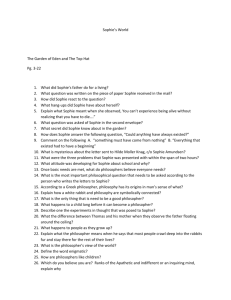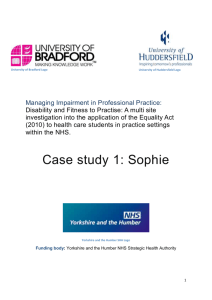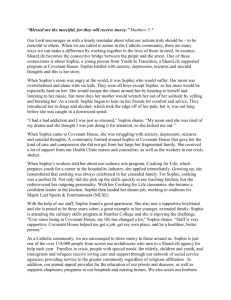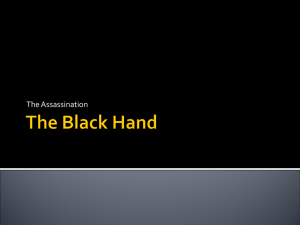Sophie Germain & Elasticity Theory: Cultural Contributions
advertisement
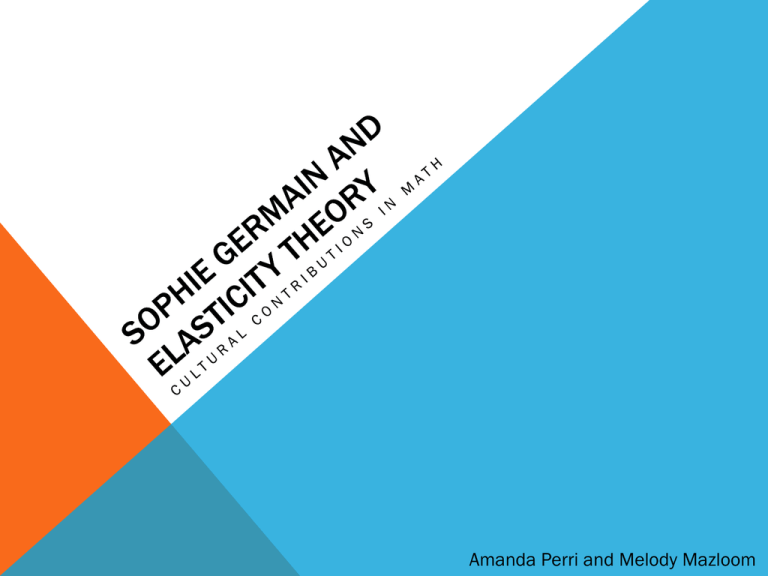
Amanda Perri and Melody Mazloom LESSON PLAN Link to google document of the lesson and recording sheet: https://docs.google.com/document/d/1qpMUaoXcqmTw750rNkDWLPEGE3aWX8u7 PHi-xP2TtX4/edit?usp=sharing PHOTOS FROM THE LESSON Practice with accuracy: Students working in groups to measure the gummy worms! A student recording the data CULTURAL CONTRIBUTIONS TO ELASTICITY THEORY SOPHIE GERMAIN Born April 1, 1776 in Paris, France Her parents were middle class, and believed, like most people during this time, that women should not pursue academic studies Grew up during the French Revolution, and was forced to stay home Spent this time reading and teaching herself all about math, despite the opposition from those around her, including her parents! PERSISTENT SOPHIE Although Sophie couldn’t formally enroll in Paris’ new Polytechnical school, she submitted papers to professors using the pseudonym M. LeBlanc One professor, J. L. Lagrange, was so impressed by Sophie, he took her on as her Mentor Sophie finally had the opportunity to meet and work with influential mathematicians and scientists of the time J. L. LAGRANGE An image of Sophie’s mentor, J. L. Lagrange, a prominent mathematician of his time SOPHIE’S LETTERS Sophie began writing letters to other prominent male mathematicians of the time, sharing her theories and discoveries, all using her pseudonym She began to be recognized for her contributions in math, although not fully She is best known for her work in Number Theory and Elasticity theory SOPHIE’S LETTERS PARIS ACADEMY OF SCIENCES PRIZE A call for papers was put out for someone to contribute to and solve some issues related to Hooke’s original Elasticity Theory Sophie submitted a paper three times, each time improving on and making corrections to her work Eventually, she received this very honourable prize for her work in Elasticity theory, which allowed her to overcome some of the barriers surrounding her HONOURS FOR SOPHIE Sadly, Sophie did not receive the recognition she truly deserved until after her death in 1831 of breast cancer, when she was fifty-five years old The university of Gottigen in Germany granted her an honourary degree, something she was denied the opportunity to pursue during her life In Paris, there is a street named after Sophie and an all girl’s school A statue in Paris also commemorates her contributions to not only math, but the advancement of women in academia Many of her letters are preserved in museums around the world HONOURS FOR SOPHIE WHAT IS ELASTICITY THEORY? Elasticity, the property of a substance that enables it to recover its original shape and size after it has been stretched, squeezed, or bent. All substances are elastic in one way or another. Solids have elasticity of form. They tend to resume their original shapes after being deformed by bending, twisting, pulling, or pressure. Some solids, such as putty and modeling clay, are plastic, or relatively inelastic. Others, such as rubber and steel, are very elastic All solids can be deformed beyond their elastic limit—the point at which they will no longer resume their original form, even if the deforming force is removed. Can you think of how elasticity theory can be used in the world around us? ELASTICITY THEORY IN EVERYDAY LIFE Elastics are used in everyday objects like clothing, can you imagine how many times we would lose our pants if we didn’t have elastics? Elasticity theory was eventually reformulated to help scientists understand what happens to the Earth’s plates after an earthquake, this theory is called Elastic Rebound Theory. Your skin is elastic! Our skin is always stretching, and eventually it begins to lose its elasticity making it unable to revert back to its original shape, like an object that has been stretched beyond its limit. This is what causes wrinkles and stretch marks! WOMEN IN MATH TODAY Sophie was revolutionary for her time, breaking down the barriers that she faced which prevented her from following her dreams Many of the barriers Sophie faced are still challenging women today. These include: Beliefs about women and math How and if women are encouraged to pursue math Media portrayals of women and men in math related careers External pressures women face WOMEN AND MATH Girls and women today are as capable and smart as anyone to excel in math and science. Sophie Germain shows us that if we are determined and committed to something we can achieve anything, despite the barriers around us! SOPHIE GERMAIN’S OF OUR TIME Dame Mary Lucy Cartwright (December 17, 1900 – April 3, 1993) Wrote over 100 papers and contributed to many mathematical theories Julia Hall Bowman Robinson (December 8, 1919 – July 30, 1985) Best known for her work on “decision problems” Shafi Goldwasser (Born 1958 -) A professor of mathematics in Israel, and won the Gödel Prize in in 1993

